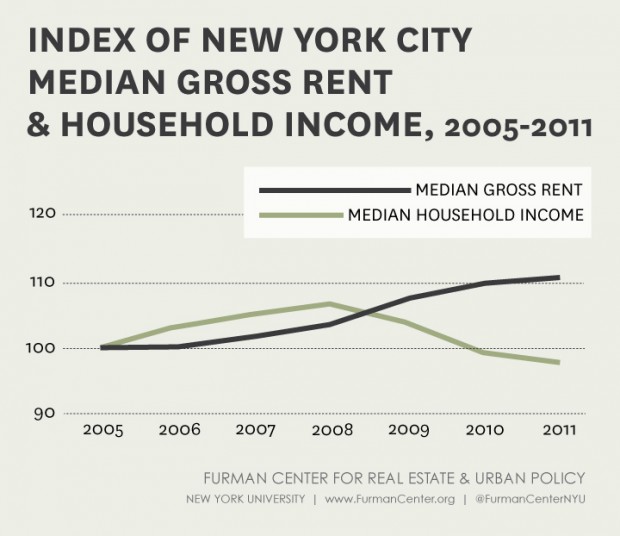
We are celebrating 15 years — and counting — of stories that are deeply researched and deeply felt, that build a historical record of what the city has been.
We are celebrating 15 years — and counting — of stories that are deeply researched and deeply felt, that build a historical record of what the city has been.
With the primaries for this November’s pivotal mayoral election a little over a week away, the Moelis Institute for Affordable Housing Policy at NYU’s Furman Center for Real Estate and Urban Policy just wrapped up its series of briefs on the ten main affordable housing issues facing the City’s next mayor. The series, dubbed #NYCHousing, departs from the well-known fact that New Yorkers, specifically low- and middle-income residents, have faced both rising rents and stagnant incomes in recent years. This challenging combination has led to a significant increase in the percentage of the city’s renters considered rent-burdened (paying 30% or more of income toward rent and utilities).

Image via the Furman Center
The question of how to create and maintain affordable housing stock, particularly in New York’s real estate market, is complex. Fortunately, the briefs produced by the Moelis Institute even-handedly provide context, background, and data needed to inform productive debate and to provide an accessible guide to affordable housing policy in New York City. The issues addressed include topics that are consistently in the news as well as those often shunted to the realm of specialists, including:
Should the next mayor require developers to permanently maintain the affordability of units developed or rehabilitated with public subsidies? (Full Brief)
“Several candidates for mayor have proposed changes to [subsidy programs that promote the development, rehabilitation, and operation of affordable units] that would require developers to make the units permanently affordable as part of the initial agreement. … However, requiring permanent affordability … may increase the cost of developing new affordable units, potentially commit the city to an ongoing subsidy, and have other consequences as well.”
Should the next mayor permit more distant transfers of unused development rights to support the development of affordable housing? (Full Brief)
“Currently, owners of the vast majority of properties [with unused rights] are not permitted to transfer development rights beyond the property’s home block. Only landmarks or properties located in a small number of designated special districts have the ability to transfer off the block. By allowing owners to transfer [the rights] farther, as long as the purchaser of the development rights included affordable housing in the building using the [rights], the city could accomplish three goals: 1) making the development rights more valuable to owners; 2) encouraging new development to help accommodate demand and support economic growth; and 3) encouraging construction of new affordable housing. Some worry, however, that wider transfers could overwhelm certain neighborhoods with additional density.”
Should the next mayor support NYCHA’s plan to lease its undeveloped land for the construction of market-rate rental housing? (Full Brief)
“NYCHA needs to close its operating and capital budget gaps, and has a limited number of options to do so. … Its leasing proposal would provide NYCHA significant and much-needed cash flows to address its capital needs. … On the other hand, some NYCHA residents and other critics have raised a number of concerns. Like all new construction, the proposed developments may take away some of the benefits the absence of development brought to neighbors (the public housing residents and others), such as open space and parking for residents and employees.”
For in depth looks at all ten top issues identified in the series, head over to the Furman Center’s website. While you’re there, also take a look at the Center’s annual State of New York City’s Housing and Neighborhoods report for neighborhood-level data and city-wide analysis.
Elsewhere on Urban Omnibus, you can find a variety of perspectives, both current and historical, on affordable housing development: take a look at the Urban Homesteading Assistance Board’s work to create cooperative housing, WHEDco’s community-building in the Bronx, the Citizens Housing & Planning Council and The Architectural League’s Making Room project, and the typology of low-rise, high-density housing in Brownsville, Brooklyn.
The views expressed here are those of the authors only and do not reflect the position of The Architectural League of New York.